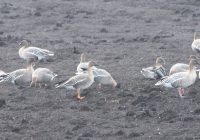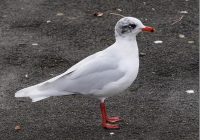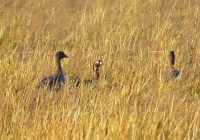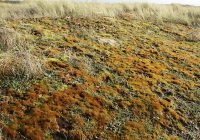Dr Phil Smith’s Wildlife Notes
January 2017
The driest autumn and winter in living memory continued throughout January with only six rain-days. Total precipitation for the Northwest was said to be 50% of normal but I suspect it was much less than that here. At the end of the month, the Devil’s Hole water-table was 16cm (6 inches) below the ground surface, a full 54cm (21 inches) lower than last year. Of course, this has major implications for our wildlife, especially the Natterjack Toad which will have very few places to breed unless there is a deluge in February and March.
Following a tip-off from Dave Hardaker, I drove across the mosses to Hillhouse on 8th to a harvested carrot field where a flock of 1900 Pink-footed Geese was clearing up the last of the spilt carrots. Views from the car were excellent and I soon picked out an adult Tundra Bean Goose with its bright orange legs. But there was no sign of the family party of four that Dave had seen earlier. The following day, the Hillhouse field was empty but I located a larger flock of about 4000 Pinkfeet on Downholland Moss, this time including the solitary Barnacle Goose I saw in December. Again, using the car as a hide, I was enjoying great views from a safe distance until another car stopped. Its occupants jumped out next to the geese, the inevitable result being that the entire flock panicked and disappeared to the north. These people were not birders, most of whom are familiar with the protocol of staying in the car when viewing wild geese.
Unfortunately, this sort of irresponsible behaviour is all too common. On the 10th, Dave was watching the same flock when a woman got out of her car and clapped her hands to spook them in order to get a “flight shot”! Apart from stressing the birds unnecessarily, this can push them onto un-harvested crops, causing conflict with the growers. These Pinkfeet and others, totalling an impressive 5000, ended up on a Barton Moss carrot field near Fine Jane pumping station. Here they were too distant from the road to search properly, even with a powerful telescope, and only the Barnacle was visible.
Good news from the Wildfowl & Wetlands Trust is that the Icelandic Pink-foot population wintering in Britain exceeded half-a-million for the first time when 536,000 were counted in October 2015. Of these, 32,200 were at Martin Mere, the third largest roost in the UK. Icelandic Whooper Swans have also increased by 16% since 2010, reaching a total of 34,000.
Reports of a Mediterranean Gull coming to bread at Southport Marine Lake prompted me to call in on two occasions during the month. Sure enough, within a few minutes of my arrival with a bag of crusts a handsome adult bird appeared just south of the pier with 100 or so Black-headed Gulls. As it came to within a few metres and posed for photographs, I was able to enjoy its distinctive white wings and bright-red bill with a black band. On my second visit, it was assuming summer plumage with the jet-black hood starting to show. I well remember being shown my first “Med Gull” by Maurice Jones on the shore at Formby Point in 1969. Then it was a rarity but this gull soon became a regular sight on our coast, with a few pairs breeding on the Ribble marshes and elsewhere from 2001. Ringing recoveries show our birds come mostly from Holland and Belgium, though one originated from as far afield as Ukraine.
Several trips to Marshside during the month were often blighted by dark clouds and gloomy light. However, the usual flocks of Wigeon, Teal and Black-tailed Godwits were enlivened by distant views of Great White Egret, Marsh Harrier and Raven. On 4th, I managed to miss a brief appearance by a Red-breasted Goose, associating with Pinkfeet. It was probably the individual that had been seen earlier in Norfolk during an influx of Pink-footed and Bean Geese. This gives it more credibility than those previously recorded in Lancashire, which have been listed as “of unknown provenance” because of the possibility of escapes from captivity.
Most of my indoor time this month was spent compiling a “Bryophyte Inventory” for the Sefton Coast. This area has long been renowned for its mosses and liverworts, with many rarities, including Baltic Bryum new to science found near Southport in 1854. Several years ago, I produced an Inventory of Vascular Plants for the Sefton Coast, so I thought it was high time to pull together all the records of the “lower” plants. This proved to be a daunting task but, using a variety of sources, I eventually ended up with a list of 225 mosses and liverworts, 23 of them being regionally or nationally notable. The total equates to about 21% of the British bryophyte flora, which isn’t bad when you consider that many species are found only in the mountains. The downside, however, is that at least 27 of them seem to be extinct here, probably due to habitat change. Most of our rare bryophytes are associated with dune-slacks that have become overgrown with coarse vegetation and scrub during the last 50 years or so. This is a familiar refrain, so many of our specialised duneland plants and animals being threatened by the same changes.




